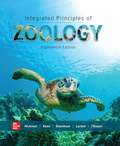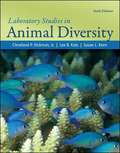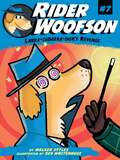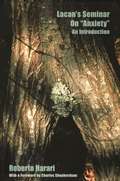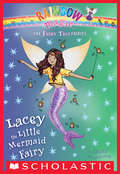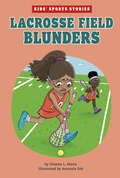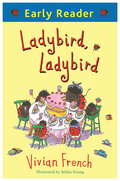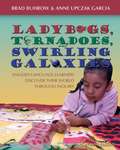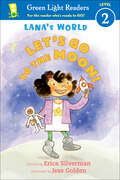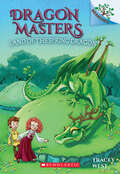- Table View
- List View
Laboratory Studies In Integrated Principles Of Zoology
by Allan Larson Cleveland P. Hickman Larry S. Roberts Helen I'AnsonLaboratory Studies in Integrated Principles of Zoology textbook.
Laboratory Studies for Animal Diversity (Sixth Edition)
by Cleveland P. Hickman Lee Kats Susan KeenLaboratory Studies in Animal Diversity offers students hands-on experience in learning about the diversity of life. It provides students the opportunity to become acquainted with the principal groups of animals and to recognize the unique anatomical features that characterize each group as well as the patterns that link animal groups to each other.
Labour Welfare And Industrial Relations
by Annamalai UniversityThe term 'Labour Welfare' is very comprehensive and includes various types of activities undertaken for the economic, social, intellectual or moral benefit of the labour community, the activities are so varied that the concept of labour welfare may vary from country to country. The royal commission on labour in India (1931) rightly pointed out: "the term welfare as applied to the industrial workers is one which must necessarily be elastic, bearing a somewhat different interpretation in one country from another, according to the different social customs, the degree of industrialisation and educational development of the worker". Hence, this book try’s to elaborate the concepts from layman’s perspective.
Labour-Intensive Industrialization in Global History
by Gareth Austin Kaoru Sugihara<p>The prevailing view of industrialization has focussed on technology, capital, entrepreneurship and the institutions that enabled them to be deployed. Labour was often equated with other factors of production, and assigned a relatively passive role. Yet it was labour absorption and the improvement of the quality of labour over the course of several centuries that underscored the timing, pace and quality of global industrialization. <p>While science and technology developed in the West and whereas the use of fossil fuels, especially coal and oil, were vital to this process, the more recent history has been underpinned by the development of comparatively resource- and energy-saving technology, without which the diffusion of industrialization would not have been possible. <p>The labour-intensive, resource-saving path, which emerged in East Asia under the influence of Western technology and institutions, and is diffusing across the world, suggests the most realistic route humans could take for a further diffusion of industrialization, which might respond to the rising expectations of living standards without catastrophic environmental degradation.</p>
Labra-cadabra-dor's Revenge
by Walker Styles Ben WhitehouseThe tricky magician Labra-cadabra-dor puts Rider under a spell in this seventh Rider Woofson adventure.When the tricky Labra-cadrabra-dor breaks out of prison, Rider gears up to face his old nemesis. But this time Labra-cadabra-dor is one step ahead and zaps Rider under an evil spell. Will Rora and the PI Pack be able to uncover the secret behind the magic trick before the act is over? With easy-to-read language and illustrations on almost every page, the Rider Woofson chapter books are perfect for emerging readers.
Lacan's Seminar on Anxiety: An Introduction (Lacanian Clinical Field)
by Roberto Harari Charles ShepherdsonDesigned for novices as well as students of psychology and literary criticism, these systematic lectures do much to clarify Lacan's groundbreaking work on the birth of the subject and its links with Freud's theory of drives. Moreover, they answer some of the criticisms that have been leveled at Lacan by forms of psychoanalysis unable or unwilling to incorporate his ideas.
Lacey the Little Mermaid Fairy: A Rainbow Magic Book (The Fairy Tale Fairies #7)
by Daisy MeadowsJoin the Fairy Tale Fairies as they make sure everyone's favorite fairy tale characters get their happily ever after! Happily Ever After? Once upon a time, Rachel and Kirsty were excited to attend the special Fairy Tale Festival at TipTop Castle. But when Jack Frost steals the Fairy Tale Fairies' magic items, stories everywhere get all jumbled up. Even worse, characters from inside the books are coming to life and finding their way into the human world! The girls only have one more magic item left to find. When Lacey's magic conch shell is returned to her, the Little Mermaid will be safely back where she belongs! Find the special fairy object in each book and help save the Fairy Tale Magic!
Lacrosse Field Blunders (Kids' Sports Stories)
by Dionna L. MannMyra encourages her best friend, Gabi, to join the lacrosse team. But learning the sport isn’t easy for Gabi. She struggles to control the ball, costing the team a painful loss. Myra, a star player, loses patience with her best friend. Will Gabi and Myra learn to be more understanding of each other before their friendship is lost?
Lacrosse Forever (Fountas & Pinnell Classroom, Guided Reading Grade 6)
by Josh Brunet Nadine McSpaddenNIMAC-sourced textbook
Ladybird, Ladybird (Early Reader)
by Vivian FrenchEarly Readers are stepping stones from picture books to reading books. A blue Early Reader is perfect for sharing and reading together. A red Early Reader is the next step on your reading journey.Mrs Ladybird is going shopping. But she's forgotten her purse. Help her five little ladybirds find their mum in time for tea! Follow their trails to see where they go.
Ladybugs, Tornadoes, and Swirling Galaxies: English Language Learners Discover Their World Through Inquiry
by Brad Buhrow Anne Upczak GarciaYou will see how the authors blend comprehension instruction and ELL best practices to explore inquiry as a literacy pathway for English language learners. As teachers and students engage in learning science and social studies content they also discover multiple ways to make meaning. The book is full of photographs of student artwork--including a color insert--that reveals the children's inquiry process, and demonstrates the important role of art as a sign system in ELL literacy and language acquisition. Brad and Anne provide explicit detail on the process they use as they move step-by-step with students from personal narrative through the independent inquiry process. They also discuss use of the Gradual Release Model, authentic assessment, and bilingual identities. Appendices in Spanish and English help to round out this informative and charming resource.
Lagartija anda suelta (¡Arriba la Lectura!, Level K #85)
by Joanne Barkan Diane PalmiscianoNIMAC-sourced textbook. Lagartija, la mascota de Luisa, anda suelta. Luisa intenta atraparla antes de que arruine la cena especial con los Montaña. ¿La encontrará a tiempo?
Lagartija pierde la cola (¡Arriba la Lectura!, Level D #16)
by Beverley Randell Bruce LauchlanNIMAC-sourced textbook. Lagartija está dormida bajo el sol. Martín Pescador tiene hambre. ¿Qué pasará?
Lagartos (¡Arriba la Lectura!, Level L #49)
by Annette SmithLos lagartos son reptiles que viven en muchos lugares de todo el mundo. Son muy listos para cazar a sus presas y para evitar a sus depredadores. NIMAC-sourced textbook
Lahar Bhag 2 Dviteey Bhasha Hindi class 7 - Andhra Pradesh Board: लहर भाग २ द्वितीय भाषा हिंदी ७वीं कक्षा - आंध्र प्रदेश बोर्ड
by State Council of Educational Research and Training Andhra Pradeshकक्षा 7 की हिंदी पाठ्यपुस्तक "लहर" भाषा और नैतिक शिक्षा का उत्कृष्ट मिश्रण है। इसमें कविताओं, कहानियों और निबंधों के माध्यम से हिंदी भाषा कौशल (सुनना, बोलना, पढ़ना, लिखना) को सशक्त करने पर जोर दिया गया है। पुस्तक में ज्ञान हम को दीजिए, होशियार कौआ, हम नन्हें बच्चे, और ईमानदारी का फल जैसे पाठ नैतिक मूल्यों जैसे सत्य, ईमानदारी, और देशभक्ति की प्रेरणा देते हैं। आदिवासी नृत्य - धिंसा और कोंडापल्ली की यात्रा जैसे पाठ सांस्कृतिक विविधता और पर्यटन के महत्व को दर्शाते हैं। साथ ही, कबीर के दोहे और सफलता का मंत्र जीवन में दिशा दिखाने का कार्य करते हैं। हर पाठ के साथ अभ्यास, व्याकरण, और परियोजना कार्य छात्रों को रचनात्मक और व्यावहारिक ज्ञान प्रदान करते हैं। यह पुस्तक भाषा सीखने के साथ-साथ आदर्श नागरिक बनने की प्रेरणा देती है।
Lahar Dviteey Bhasha Hindi class 6 - Andhra Pradesh Board: लहर द्वितीय भाषा हिंदी ६वीं कक्षा - आंध्र प्रदेश बोर्ड
by State Council of Educational Research and Training Andhra Pradeshकक्षा 6 और 7 की हिंदी पाठ्यपुस्तकों "लहर" का मुख्य उद्देश्य छात्रों में हिंदी भाषा के प्रति रुचि और सृजनात्मकता उत्पन्न करना है। इन पुस्तकों में बाल गीत, कहानियाँ, कविताएँ, और व्याकरणिक अभ्यासों को शामिल किया गया है। उदाहरण स्वरूप, "प्यासा कौआ," "साबरमती का संत," "दो मित्र" जैसी कहानियाँ नैतिक मूल्यों जैसे ईमानदारी, परिश्रम और मित्रता को दर्शाती हैं। बाल कविताएँ जैसे "आओ बच्चे," "मेरी बहना," "तरकारी दरबार" सरल शब्दों में जीवन और प्रकृति का महत्व समझाती हैं। पाठों के अंत में व्याकरण, वर्णमाला, और लेखन अभ्यास दिए गए हैं, जो छात्रों के भाषा कौशल को मजबूत करते हैं। साथ ही, पुस्तक में त्रिभाषा सूत्र का पालन करते हुए सुनने, बोलने, पढ़ने और लिखने के कौशल के विकास पर जोर दिया गया है। चित्रों और खेल-आधारित गतिविधियों से छात्रों का भाषा सीखना रोचक और प्रभावी बनाया गया है। ये पुस्तकें छात्रों को रचनात्मकता, नैतिकता और सामाजिक मूल्यों की शिक्षा प्रदान करती हैं, जो उन्हें आदर्श नागरिक बनने में सहायता करती हैं।
Lana's World: Let's Go to the Moon (Green Light Readers Level 2)
by Erica SilvermanThe story of a little girl who wants to fly high, from the author of the Cowgirl Kate and Cocoa series!When little Lana suggests a family adventure to the moon, Papa, Mama, Jay, Ray, and even Furry the dog have excuses not to go. But that&’s not enough to stop the imaginative and resourceful Lana from rocketing into space and ultimately getting her whole family to blast off with her… Vroom! Zoom! Whoosh! Welcome to Lana&’s World!
Land Revenue Code, 1968 and Rules.
by The Government of GoaThis book is from Government of goa about land renvenue code 1968 and Rules.
Land Under Siege: The Marshall Islands / Lessons of a Nuclear Age: The Bikini Atoll (Fountas & Pinnell Classroom, Guided Reading Grade 6)
by Margie Sigman Betty RiggsNIMAC-sourced textbook
Land of the Spring Dragon: A Branches Book (Dragon Masters #14)
by Tracey WestDrake travels to a secret fairy world to save the Kingdom of Bracken!Pick a book. Grow a Reader!This series is part of Scholastic's early chapter book line, Branches, aimed at newly independent readers. With easy-to-read text, high-interest content, fast-paced plots, and illustrations on every page, these books will boost reading confidence and stamina. Branches books help readers grow!Drake's kingdom is in trouble -- a terrible earthquake has destroyed Bracken's crops! A magical Spring Dragon has the power to save the kingdom and regrow the crops, but he lives deep inside a secret fairy world. To find the Spring Dragon, Drake must pass a series of tests given by a Dragon Master named Breen. But the fairy world is full of confusing tricks and mysterious riddles! Can Drake save his kingdom?
Land, People, Nation: A History of the United States (3rd Edition)
by Anna Uhl Chamot Kathleen Anderson SteevesLand, People, Nation: A History of the United States helps English language learners and struggling readers develop academic language skills for learning history and geography. The engaging readings and illustrations, maps, charts, and graphs build valuable interpretive skills for students as they master academic content.
